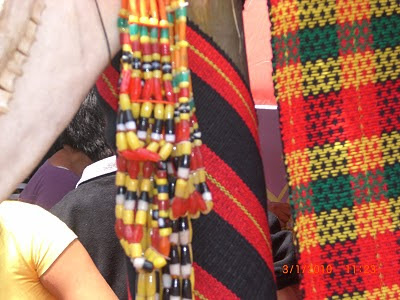Igorot costumes are similar to Kalinga costumes; however, there are certain differences that an observant could notice.
Let’s discuss them in detail.
Kalinga Ginamat
In Kalinga, the ginamat is a rectangular woven material that usually measures 4 to 5 feet long and 3 to 3.5 inches wide.
This is for women and is worn as a skirt by winding it around the waist and hooking it up at the ends. Unlike the Bontocs, the ginamats for Kalingas don’t have an accompanying ‘tail’ or ginamat back extensions.
There may be beads incorporated into the colorful ginamat’s design but no belts or additional appendages. This is one of the Kalinga native costumes that have intricate designs.
During the olden times, women wore only the ginamat without any upper clothing. Thus, women are topless, especially married and old women.
The clothing is entirely hand woven, done by ingenious women, who patiently created art through their woven materials.
Up to this day, back in the provinces, ginamats are still hand woven. However, in the big cities, some machines were built to facilitate the procedure of weaving the ginamat.
Kalinga G-string
This Kalinga native costume is worn by men to hide their lower private parts. It’s similar to the ginamat but narrower and longer.
It usually measures more than 5 feet in length but is only around ¾ foot in width. It’s worn by winding the woven material on the waist and the lower private parts to secure the G-string.
Typically, the cheeks of the buttocks are not covered but only the anal and penile areas. There’s also no upper clothing for men - just the G-string.
For other Cordillera regions the G-strings are the same, except perhaps with the designs. Nowadays, The G-strings are wider to be able to cover most of the buttocks.
But still, briefs are not worn, but only the G-string. And yes, the Kalingas are now wearing trendy clothes, just like their urban counterparts.
Ginamats and G-strings are only worn during cultural festivities and special occasions.
Kalinga Accessories Worn with the Ginamat
Kalinga Bongor.
The bongor is a string of beads worn like a necklace. The beads are genuine gems and are valuable.
Kalinga women who had bongors are usually the affluent and people who have high positions in the village. The bigger the beads are, the richer the person is.
Often, one piece of these genuine beads is worth 1 carabao. And the carabao is an expensive animal because it’s used as a work animal.
Hence, you can just imagine how expensive the beads are. Perhaps, comparing to the present price of carabaos, it could cost around 7 thousand to 10 thousand pesos.
The present generation has created native beads that could be worn on top of the head on the wrist (bracelet) and feet (anklet).
Kalinga Headdress
Aside from women wearing headdresses, men can also wear them. Sometimes, the “crown” is adorned with feathers and natural items.
Presently, Kalingas have become more ingenious, creating beautiful headdresses.
Tattoo,
Although this is not an accessory in the true meaning of the word, it’s considered as one because people with tattoos were highly respected.
Tattoos are indications of bravery and high prestige. The younger Kalinga generation; however, are not so keen in having themselves tattooed because they may be discriminated on.
This is understandable as tattoos are prohibited in most schools, in blood donation, and in other significant events and institutions.
Almost all of the elders are tattooed, and they are proud of their ethnicity.
These are the basic Kalinga costumes worn during the olden days.
Of course, with the passage of time, the native Kalinga costume underwent some changes.
Nowadays, Kalinga women wear blouses during cultural presentations.
But take note that there was a time when women were topless, and people in the village didn’t find anything malicious with it; they were not embarrassed at all.
Only the men remain topless and semi-nude.
So, there you go, these are the descriptions of the basic Kalinga costumes.
You can view the images to have an idea how they look like.
Ciao!








No comments:
Post a Comment